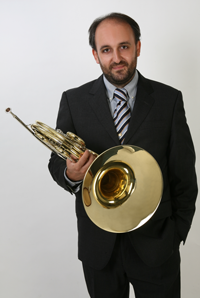ca.4 min
Published in October 2019 at AvA Musical Editions
Also available at Köbl •
Repertoire piece for the IV Concurso Adácio Pestana (2020) and the Matosinhos Internacional Competition 2024.
This piece was composed for the horn player Andrew Savage, in gratitude for having accepted to collaborate with my PhD research. Mirage is a piece clearly influenced by the sonorities of the south of Spain and all the relations of the country with the Muslim world.
It is used the Phrygian dominant mode in most of the sections. So, instead of opting for standard key signatures and adding local accidentals, which is a practice clearly influenced by the limitations imposed by music notation softwares, whenever necessary I chose to include key signatures corresponding to the Phrygian dominant mode, as now thanks to Dorico (Steinberg) composers are now longer limited to the traditional options. For sure, on a first approach, it might look hard to read because it presents a sequence of accidentals that don’t follow the traditional cluster, however this way the score looks cleaner. Besides, the use of the alternation of the fingering sequences most of the times, enables that only the 2nd finger moves.
Between bar 18 and 25 the standard fingerings (especially on the B♭ side of the horn) could become too difficult. On this type of passages, I like to use a special technique that consists on changing the normal position of the left hand fingers, moving them forward one key lever. So, the first finger moves forward to the 2nd key lever and the 2nd finger moves to the 3rd key. This way, an apparent non idiomatic passage due to a very difficult fingering combination that makes it difficult to play with the proper flow, becomes idiomatic when the proper playing technique is used. This hand movement requires a rest or a note where none of the fingers is being used, in order to allow their movement from/to the new setting. Because this technique isn’t usually described, I’ve placed a line to enclose its usage and indicated the corresponding fingerings for the 1st and 2nd fingers on its new setting.
As for the multiphonics, if this piece is interpreted by a horn player with a higher pitched vocal range, these should be adapted, while keeping the same character of the piece. Other effects that help to characterize this piece include tremolos that intend to imitate the tremolo of a guitar, or the sound of castanets obtained by beating with the right hand nails against a wooden mute.
Ricardo Matosinhos



